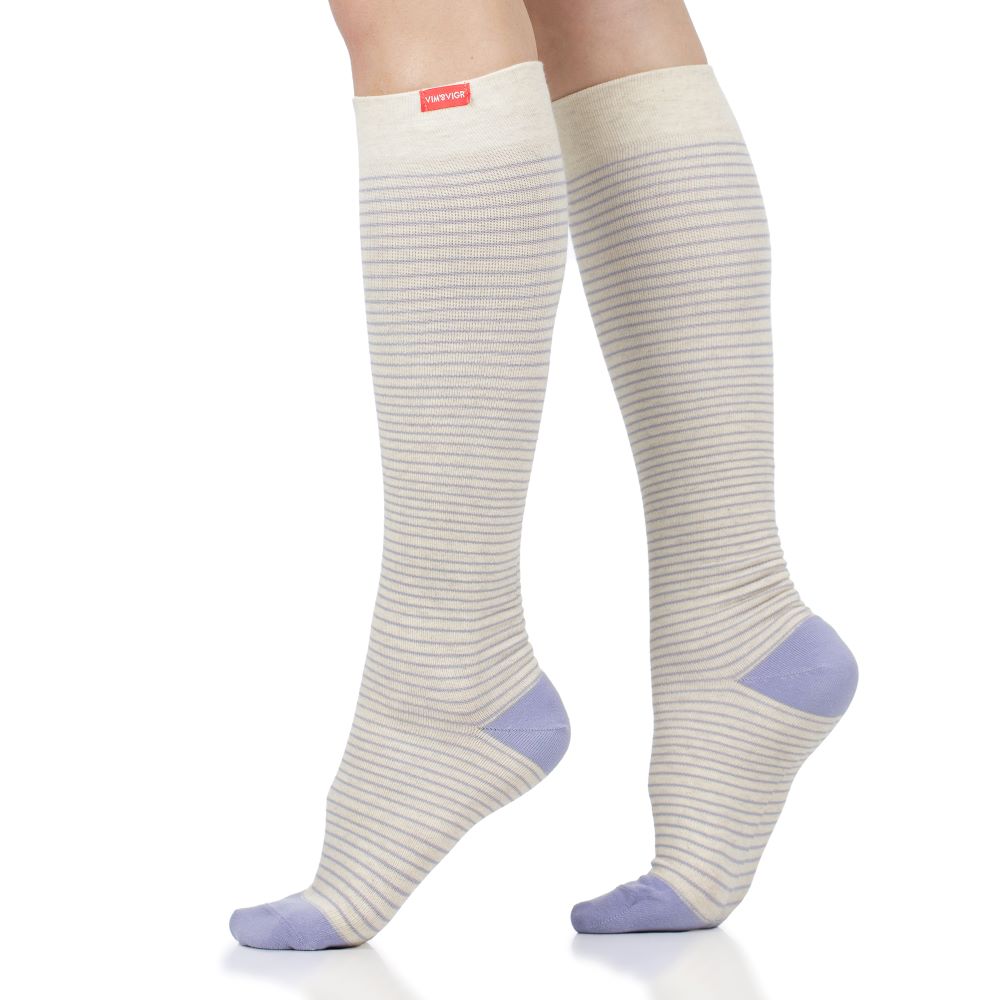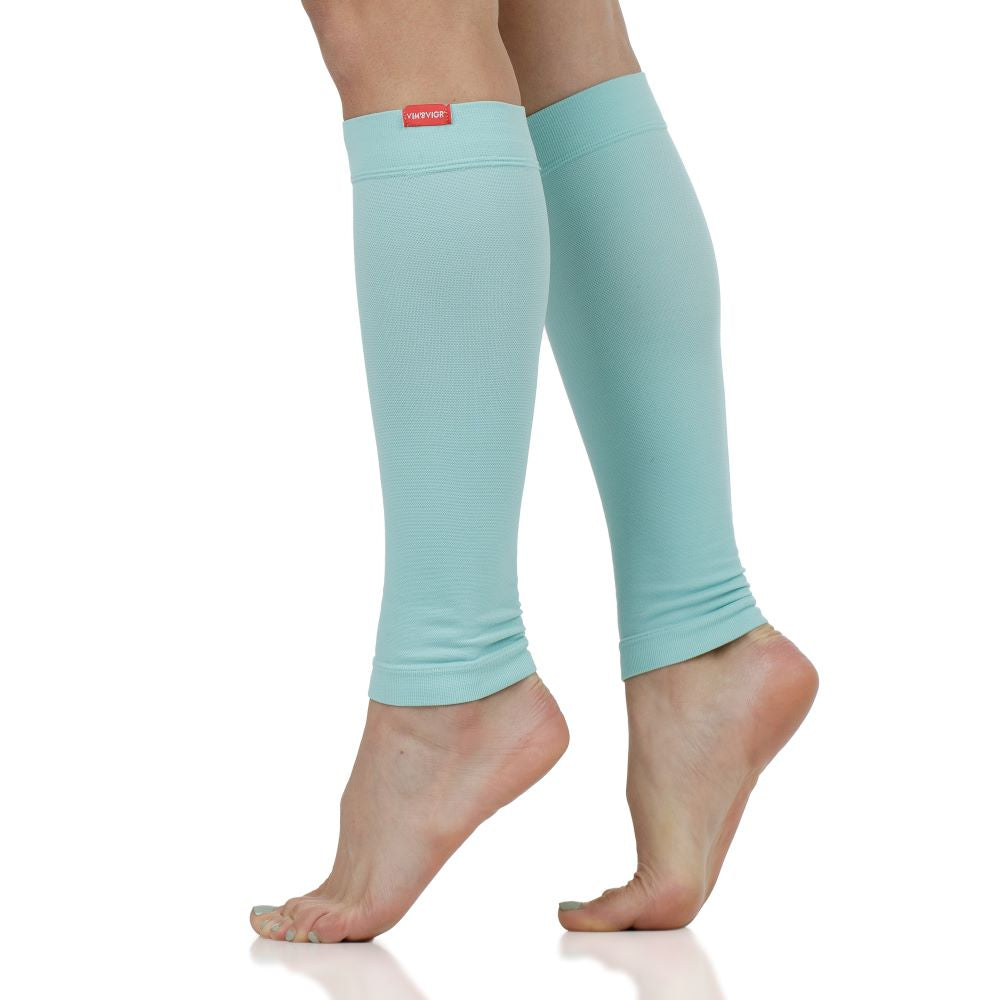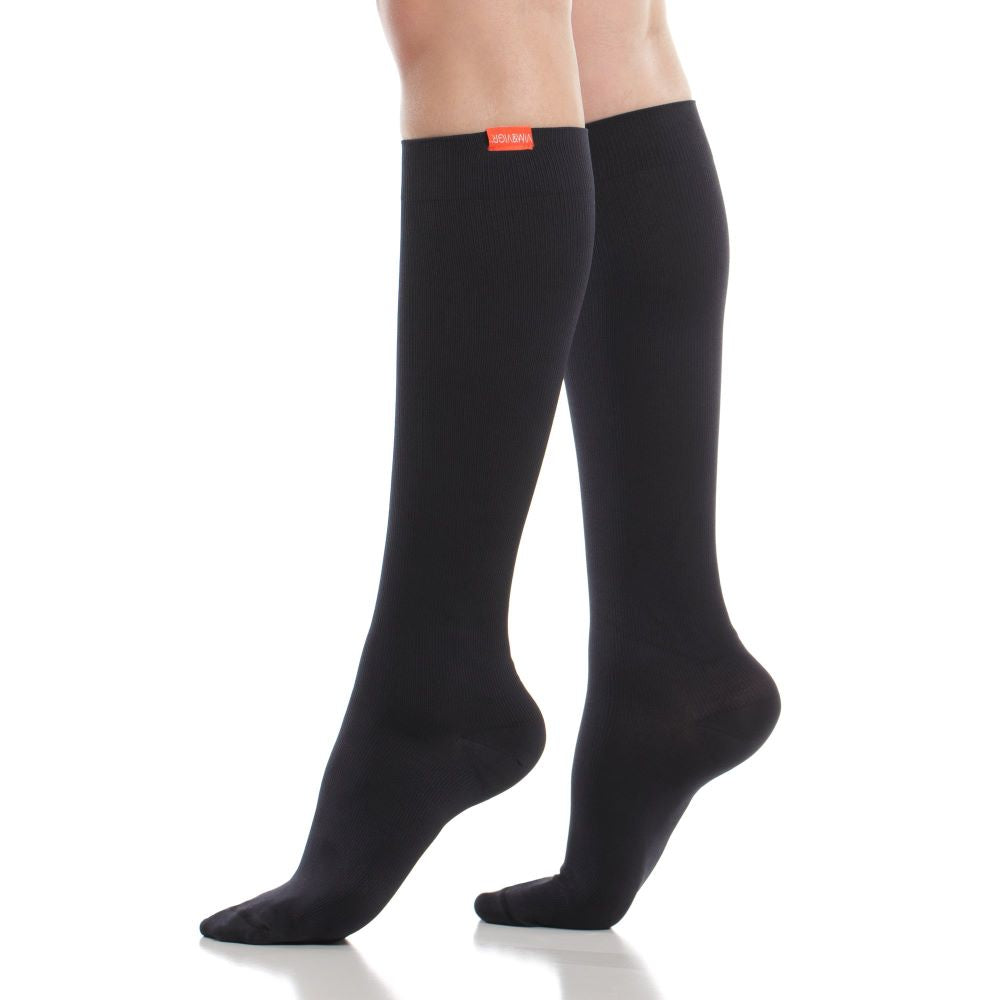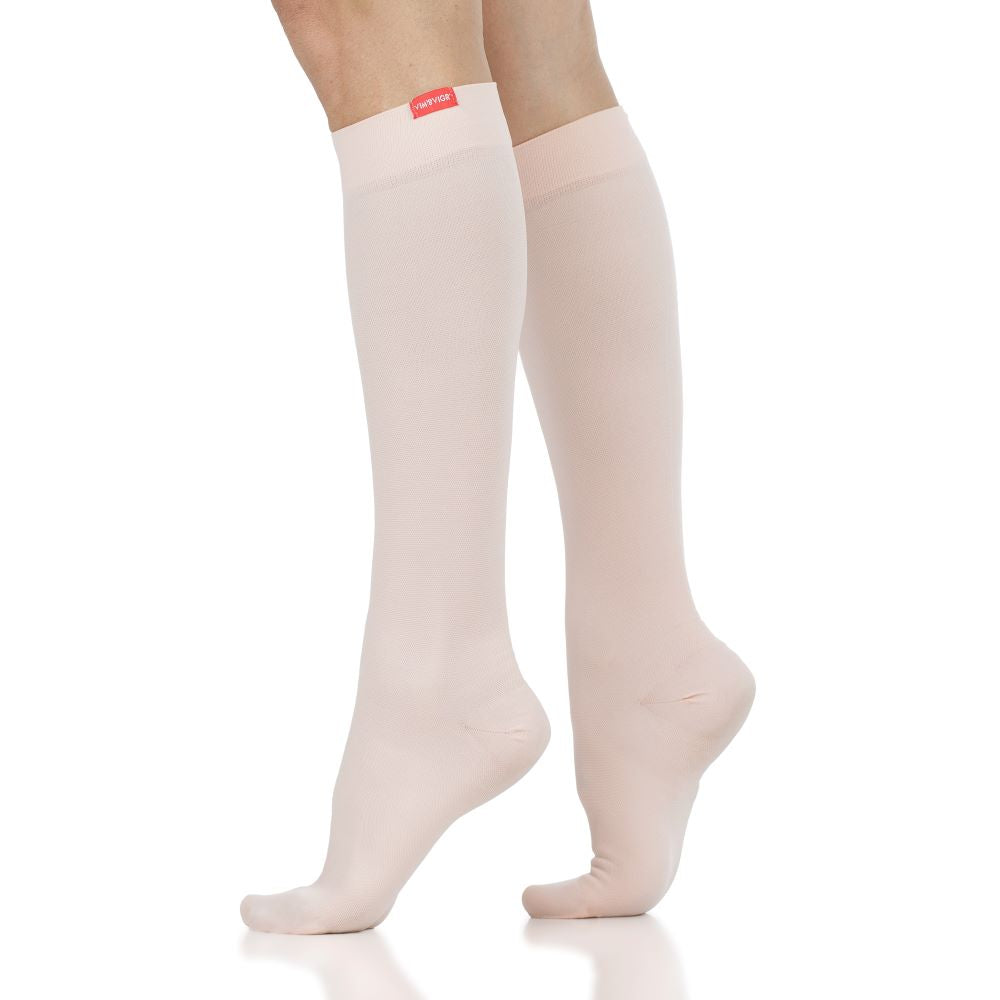POTS Compression Socks: The Benefits and How to Use Them
Scientifically Reviewed by Daniel Chantigian
Are Compression Socks Good for POTS?
Because of how compression socks apply therapeutic pressure to the lower legs, compression socks are a very useful tool in dealing with POTS symptoms. They help stimulate blood flow back to the heart when moving from sitting or lying down to standing, which can prevent POTS symptoms like a rapid increase in heart rate and lightheadedness.
Wearing compression socks when sitting for long periods of time, as well as when you are bed-ridden, can help improve circulation and reduce the likelihood of low blood flow to the brain (a key trigger for the discomfort associated with POTS). They are an easy to use, convenient, versatile type of garment that can be worn in any setting and adapted to weather conditions, activity levels, or outfit choice.
What is POTS?
Postural orthostatic tachycardia syndrome (POTS) is a form of dysautonomia – AKA a disorder of the autonomic nervous system (ANS). The ANS regulates the functions of the body we do not think about, such as our heart rate or breathing. It also controls our blood pressure, which is severely affected by POTS and other forms of dysautonomia. A 2023 study found that up to 3 million people in the United States alone suffer from POTS.
People with POTS struggle directly with their heart rate increasing too rapidly when moving from sitting or lying down to standing. Johns Hopkins Medicine breaks POTS down this way:
- Postural: related to the position of your body
- Orthostatic: related to standing upright
- Tachycardia: increased heart rate
- Syndrome: a group of symptoms
Researchers are continuing to learn about the causes of POTS, and recent studies have tried to identify symptoms and find treatments. We can currently list the following symptoms of POTS:
- Lightheadedness (occasionally with fainting)
- Difficulty thinking and concentrating (brain fog)
- Fatigue
- Intolerance of exercise
- Headaches
- Shakiness
- Blurry vision
- Heart palpitations or rapid increase in heart rate when standing
- Problems regulating blood pressure
- Tremor
- Nausea
Diagnosing POTS can be tricky and often takes a very long time, since other chronic conditions need to be ruled out first. According to Johns Hopkins Medicine, this condition can be diagnosed only when orthostatic hypotension, dehydration, or blood loss have been ruled out. Then, you will perform a 10-minute standing test or a tilt table test and be tested to see if you exhibit a set of symptoms when you move from lying down or sitting to standing upright.
If, in these scenarios, you experience a heart rate increase of at least 30 beats per minute in adults (or at least 40 beats per minute in adolescents), during the first 10 minutes after standing, you will likely be diagnosed with POTS.
The Benefits of Compression Socks for POTS
Several studies have shown that compression can help those suffering from POTS, particularly when worn on the lower body. Compression socks play a key role in stimulating local blood flow and regulating whole-body circulation, which is why they can be extremely useful for people with this condition.
Regulation of Heart Rate and Blood Pressure
Graduated compression socks have been found to boost blood flow back to the heart from the lower extremities to preventing a sudden drop in blood pressure when you move from sitting to standing. This action helps keep a constant and consistent volume of blood flowing to the brain, reducing the risk of having the “dizzy spells” associated with POTS.
Improved Blood Circulation
Since compression socks prevent blood from pooling in the lower legs, they can improve whole-body blood flow, as found by this key scientific study. The effects of compression socks can help keep your energy levels up and reduce the risk of swelling and pain in the legs.
Reduced Venous Pooling and Enhanced Venous Return
Compression socks stimulate blood flow to the lower legs, push fluid from areas it should not be to go back into the deeper veins, and help maintain the health of your circulatory system. Compression socks improve venous return, which is the volume of blood which flows back towards the heart from the rest of the body. How compression socks improve venous return is key to preventing POTS symptoms.
Reduced Dizziness and Lightheadedness
Healthy blood circulation means that you are less likely to find yourself getting lightheaded when standing up. This is a key benefit of wearing compression socks when you’re not moving for extended periods of time, such as going on a long flight or car journey. Instead of succumbing to the downward pressure of gravity, your veins keep pumping up blood towards the heart, keeping you more balanced overall and reducing the risk of POTS symptoms.
Minimized Swelling and Edema
A lot of lower leg swelling and/or edema is caused by poor peripheral circulation. Thanks to how they stimulate blood flow, compression socks reduce the risk of discomfort from leg swelling or edema. Additionally, compression socks help massage the lower legs, relieve pressure on the muscles, and help reduce swelling you put on compression socks once you already feel “heavy legs.”
How Compression Socks Help with POTS Symptoms
By using therapeutic pressure, compression socks assist blood vessels in moving blood through the body, so it doesn't pool in the legs (where gravity or other reasons could block healthy blood flow). This makes compression socks an effective preventative tool for POTS symptoms, which are directly linked with blood pooling in the lower extremities.

A scientific study from 2021 found that lower leg compression provides relief to POTS patients. This is even more effective when wearing graduated socks or stockings. These garments are tightest at the ankle and get gently looser towards the top (knees or waist). This contributes to gently moving blood from the lower legs and supporting the veins, which also helps to prevent varicose veins.
How to Use Compression Socks for POTS
Wearing compression socks helps push blood upwards from the lower extremities, as well as into the deeper veins (as opposed to allowing it to pool in superficial veins). Research shows that knee-high socks help reduce the symptoms of POTS, as do longer garments like compression stockings or tights, or even abdominal compression garments like a girdle or binder.
In addition to the use of compression socks, doctors from Harvard recommend lifestyle changes that can help those suffering from autonomic disorders. Surprisingly, one randomized controlled trial (the gold-standard for research) recommended that people with POTS should add more sodium into their diet. It was found to limit the change in heart rate when you move from sitting to standing. People suffering with POTS are basically suffering from insufficient circulating blood volume, and more salt in your diet helps you keep more fluid in your circulatory system. Drinking more fluids also helps with this (so make sure you stay well hydrated!), but the key is to have enough sodium in the body to keep fluids circulating. Be sure to consult your doctor to make sure it is healthy for you to increase your salt intake.
Some other actions that can provide relief from lightheadedness or dizziness brought on by POTS include:
- Avoiding any potential blood pressure lowering triggers like skipping meals, insufficient sleep, hot baths and saunas, and meals featuring lots of carbohydrates;
- Using a small board under the mattress to raise the head height slightly when sleeping;
- Using specific medication in agreement with your doctor.
The Best Compression Socks for POTS
It is extremely important to find a compression sock that is comfortable if you suffer from POTS. This is because wearing compression socks is kind of like brushing your teeth, consistency matters! So, you need to choose well and wear them often and consistently, to stimulate blood flow and reduce dizziness and discomfort. We at VIM & VIGR pride ourselves on making extremely comfortable socks so you can consistently use them. We also stress the importance of using graduated compression to really support that upwards blood flow from the lower legs.
The Importance of Graduated Compression for POTS
Since graduated compression socks directly stimulate upwards blood flow, they are one of the most effective types of clothing for dealing with POTS symptoms. The main cause of POTS symptoms comes down to the blood not effectively traveling to the brain when you move from sitting to standing. This can be caused when you sit or lie down for long periods of time (from desk jobs to post-surgery recovery to anything in between).
Wearing stockings or knee-high socks that provide graduated compression boosts upwards blood flow. It is helpful for veins that struggle to transport the blood towards the heart and can be a game changer for everyday POTS sufferers.
Understanding mmHg and Compression Levels
Compression socks are really easy to wear and are safe to keep on for as long as you’re comfortable. But not all compression socks are the same: the therapeutic pressure applied varies, so we recommend checking this with a medical professional if you have any concerns. For POTS, we generally recommend compression levels of 20-30 mmHg or even 30-40 mmHg depending on severity.
Here are all the pressure levels we offer:
- 15-20 mmHg: moderate support, ideal for all-day, everyday wear. Offers moderate support to reduce ankle and leg swelling, ease tired and achy legs, and aid in muscle recovery. Commonly used for travel, mild to moderate edema, pregnancy, spider and varicose veins.

- 20-30 mmHg: moderate to firm support, often recommended or provided on prescription from a doctor. Please consult with your healthcare provider before choosing this level of support. Commonly used for moderate edema, lymphedema, Deep Vein Thrombosis (DVT), pre and post-surgical applications, moderate spider and varicose veins.

- 30-40 mmHg: firm, prescription level support. Used to treat health conditions such as venous insufficiency, deep vein thrombosis (DVT) and lymphedema. These can only be purchased with a prescription.

Compression Sock Types to Consider
Studies show that compression garments that are longer, going up to the waist generally, are more effective in fighting the blood flow problems that cause POTS symptoms. You can start with knee high compression socks to get familiar with the feeling of therapeutic pressure and then move on to tights. Sizing and fabric are also important elements for making your purchasing decision.
Knee High Compression Socks
These “classic” compression socks go with any outfit and give you lots of versatility. You can wear them for sports activities, everyday work or casual scenarios, and even to bed. Graduated socks boost circulation from the ankles and lower legs upwards, while also massaging the calf muscles and supporting the lower legs and feet.
Compression Tights
Tights offer better coverage and support for the knees and upper legs as well. They can give you a sense of added stability, while also boosting overall blood flow.
Open Toe Compression Stockings
If you want to wear sandals or need to let your toes breathe, you can still benefit from compression with
open toe options that are also quite stylish.
Finding the Right Size and Fit
To get the full benefits on the circulatory system, your compression socks need to fit well. If they’re loose, they won’t actually apply the required amount of pressure to boost blood flow. And, if they’re too tight, they can become an added source of discomfort and pain and even cut off your circulation. Ensure you get the right size by following our instructions.
Functional Fabric Options
Finally, the choice of fabric can make or break your experience of compression socks. We offer an array of fabrics that work best in different circumstance and climatic conditions.
Cotton
Our 200-needle count cotton blend is soft and made with natural fibers. Its flexibility allows for our funkiest designs, and many customers report that their feet stay cool while wearing them - even in the summer months!
Merino wool
We use the highest quality (sustainably sourced) Merino Wool for our socks. This 200 needle count fabric is known for its moisture-wicking and temperature regulating properties. It’s great for everyday wear and for outdoor activities.
Nylon
For the longest time, we have knit our nylon socks on a 400 needle count machine, which left a high quality sleek feel to the sock, and a 4-way stretch that was unmatched. However, it limited our ability to make fun designs, and left a seam in the toe. In 2022, we released another version of our nylon sock called Choice Nylon. This uses the same fabric as our Classic Nylon socks, but leaves a softer feel and allows for more designs, all while eliminating the toe seam.
We also offer leg sleeves in Nylon, which offer a way for POTS patients to have their feet free but still benefit from compression.
Moisture-wick nylon
This high-quality nylon is also great for temperature regulation. It uses a different fabric than our Classic Nylon and Choice Nylon socks and is knit on a 400 needle count machine. These socks give the feeling of stockings and are loved by many of our customers.
References
Meskill, G., Rege, R., & Meskill, S. (2023). An observations retrospective study of the prevalence of comorbid postural orthostatic tachycardia syndrome (POTS) in narcolepsy. Sleep, 46(Supplement_1), A257-A258. Read it here.
John Hopkins Medicine. (2019). Postural Orthostatic Tachycardia Syndrome (POTS). John Hopkins Medicine. Read it here.
Bourne, K. M., Sheldon, R. S., Hall, J., Lloyd, M., Kogut, K., Sheikh, N., Jorge, J., Ng, J., Exner, D. V., Tyberg, J. V., & Raj, S. R. (2021). Compression Garment Reduces Orthostatic Tachycardia and Symptoms in Patients With Postural Orthostatic Tachycardia Syndrome. Journal of the American College of Cardiology, 77(3), 285–296. Read it here.
Lim, C. S., & Davies, A. H. (2014). Graduated compression stockings. CMAJ : Canadian Medical Association journal = journal de l'Association medicale canadienne, 186(10), E391–E398. Read it here.
Lee Lewis, D. K. (2021, October 6). POTS: Diagnosing and treating this dizzying syndrome. Harvard Health. Read it here.
Garland, E. M., Gamboa, A., Nwazue, V. C., Celedonio, J. E., Paranjape, S. Y., Black, B. K., Okamoto, L. E., Shibao, C. A., Biaggioni, I., Robertson, D., Diedrich, A., Dupont, W. D., & Raj, S. R. (2021). Effect of High Dietary Sodium Intake in Patients With Postural Tachycardia Syndrome. Journal of the American College of Cardiology, 77(17), 2174–2184. Read it here.




















Leave a comment